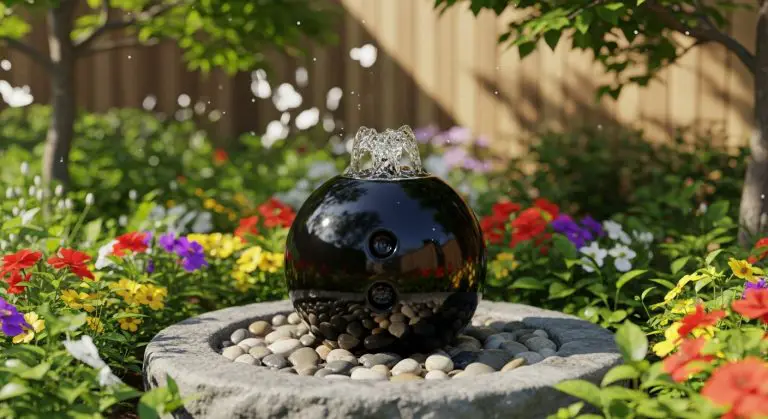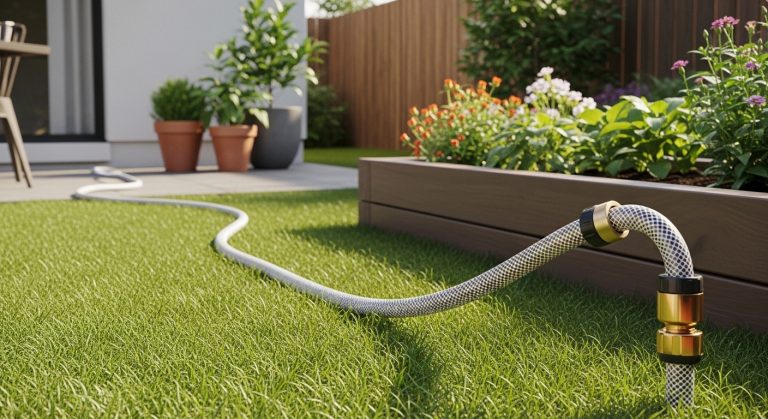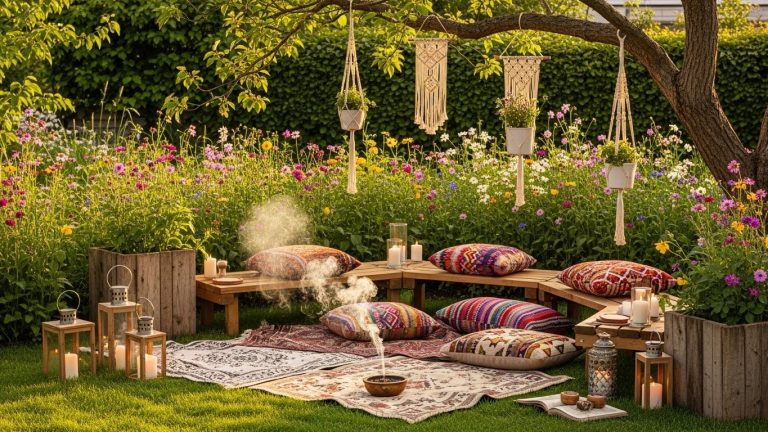Astilbe and Hosta Garden Ideas: 15 Lush, Dreamy Designs for Shade-Loving Spaces
There’s something magical about a shady corner bursting with texture and color — the kind of spot that feels like a secret garden you stumble into on a quiet afternoon. That’s exactly what astilbes and hostas can do together. I’ve been obsessed with this pairing for years. The way astilbe’s feathery plumes rise above hosta’s bold leaves? It’s like watching lace meet velvet. Elegant. Effortless. And incredibly forgiving for gardeners who crave beauty without constant fuss.
Whether you’ve got a tricky north-facing bed or a backyard patch that never sees full sun, these two plants can transform it into a layered, living painting. Below, I’ve gathered 15 inspiring astilbe and hosta garden ideas — from woodland retreats to minimalist modern corners. Each one includes pros, cons, and real-world takeaways you can use right away.
1. Woodland Pathway Paradise

Picture this: a dappled woodland path lined with drifts of hostas and astilbes glowing in soft morning light. It’s classic, timeless, and perfect if you love that enchanted forest vibe.
Pros:
- Creates a lush, natural feel that looks established quickly.
- Low-maintenance once planted — just mulch and occasional watering.
- Attracts pollinators like bees and butterflies to the astilbe blooms.
Cons:
- May struggle in very dry shade without consistent moisture.
- Fallen leaves in autumn can hide slugs (keep an eye out!).
Takeaway: A shaded path with alternating hostas and astilbes feels like a nature trail through your own backyard sanctuary.
2. Japanese-Inspired Serenity Garden

Ever admired those peaceful Japanese gardens where every texture and color feels intentional? Astilbe and hosta fit right in. Mix green hostas with soft pink or white astilbe blooms among stones and moss for pure tranquility.
Pros:
- Perfect for small spaces — compact but rich in detail.
- Works beautifully with stone lanterns, gravel, and bamboo edging.
- Offers year-round interest: foliage in spring, blooms in summer, structure in winter.
Cons:
- Needs clean design restraint — overplanting breaks the zen.
Takeaway: This combo turns shade into a minimalist retreat where every leaf feels meditative.
3. Cottage Shade Border

If your garden leans more cottage-core than minimalist, try layering astilbes and hostas with ferns, bleeding hearts, and brunnera. The result? A romantic shade border that looks lush from May through September.
Pros:
- A textural mix of fine and bold foliage adds depth.
- Astilbes offer that soft, airy contrast to hosta solidity.
- Works along fences, beneath trees, or near porches.
Cons:
- Can look crowded without careful spacing — give plants room to breathe.
Takeaway: A cottage border lets you embrace wild beauty while keeping the focus on astilbe’s grace and hosta’s reliability.
4. Pondside or Water Garden Accent

Astilbes love moisture, and hostas can handle damp soil surprisingly well. Pair them near a pond or fountain, and you’ll get reflections of pink, white, and green shimmering on the water’s surface.
Pros:
- Thrives in moist, shady zones most plants avoid.
- Creates a cooling, serene atmosphere near water.
- Foliage contrasts beautifully with rocks or stepping stones.
Cons:
- Needs some slug control — moisture attracts them fast.
Takeaway: Use water as a natural mirror to double your garden’s visual impact — astilbe and hosta reflections are pure poetry.
5. Monochrome Green Garden

Not every garden needs flowers to shine. A monochrome green palette, mixing chartreuse, emerald, and blue-green hostas with pale green astilbes, creates a calming, modern vibe.
Pros:
- Super low-maintenance and cohesive — fewer color clashes.
- Highlights shape, form, and texture instead of blooms.
- Works beautifully in contemporary landscapes.
Cons:
- May feel too subtle for those who crave bright color pops.
Takeaway: Green-on-green planting turns simplicity into sophistication — proof that color restraint can be dramatic.
6. Front Yard Shade Statement Bed
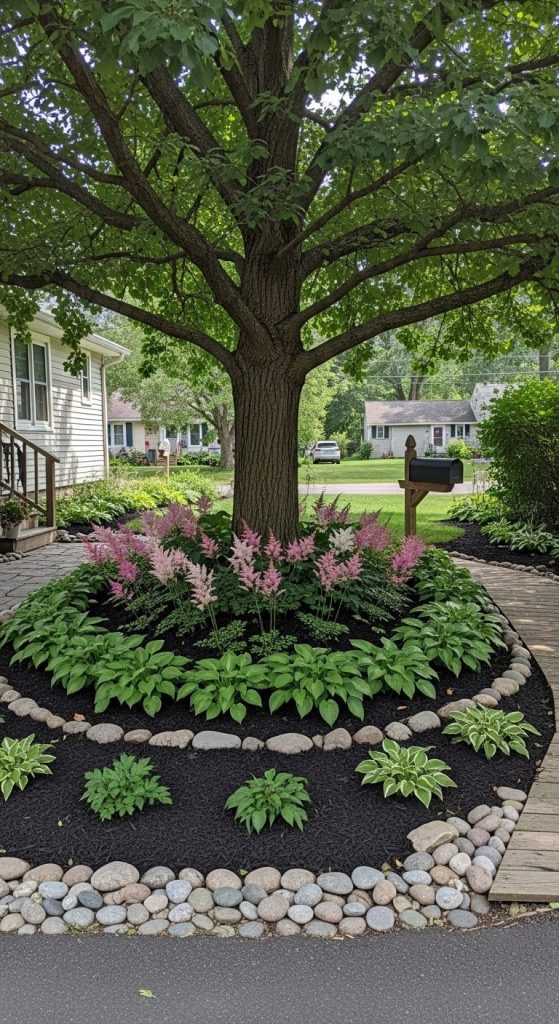
Tired of struggling to grow grass under a big tree? Replace that patchy turf with a bold hosta and astilbe bed instead. It’s low effort and looks like professional landscaping.
Pros:
- Boosts curb appeal instantly with lush, layered foliage.
- Low water needs once established.
- Seasonal color from astilbe plumes adds curbside charm.
Cons:
- You’ll need to amend poor, compacted soil before planting.
Takeaway: Shade-loving perennials can turn a problem area into a feature bed worth bragging about.
7. Hostas as Living Borders
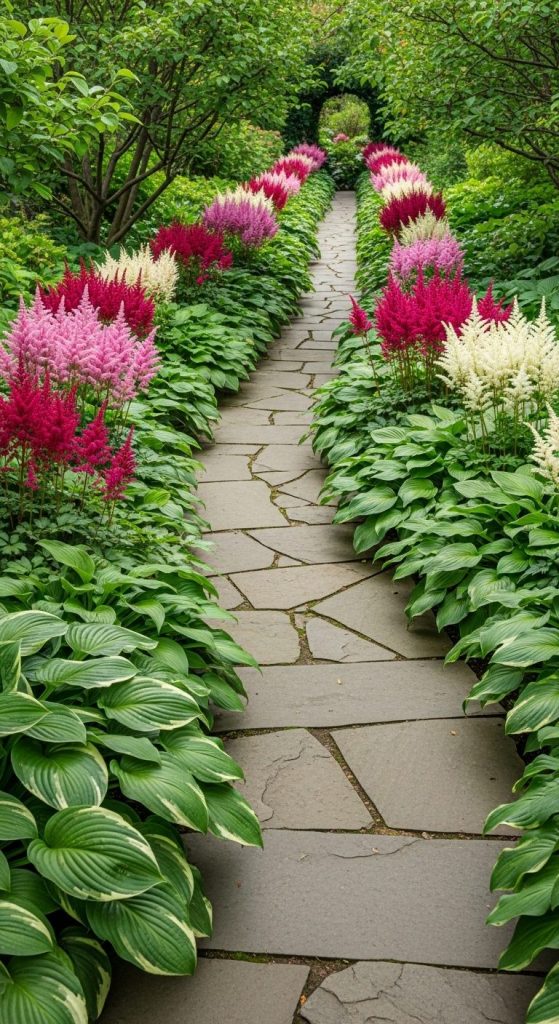
Sometimes the best design trick is simplicity. Use large hostas as living borders to define astilbe groupings — like leafy picture frames around soft flower plumes.
Pros:
- Neat structure without needing edging materials.
- Hostas suppress weeds and retain soil moisture.
- Perfect for pathways or garden edges.
Cons:
- Requires annual cleanup as hosta leaves die back in fall.
Takeaway: Living borders feel alive and change subtly with the seasons — more personality than bricks or stones ever offer.
8. Shade Container Garden
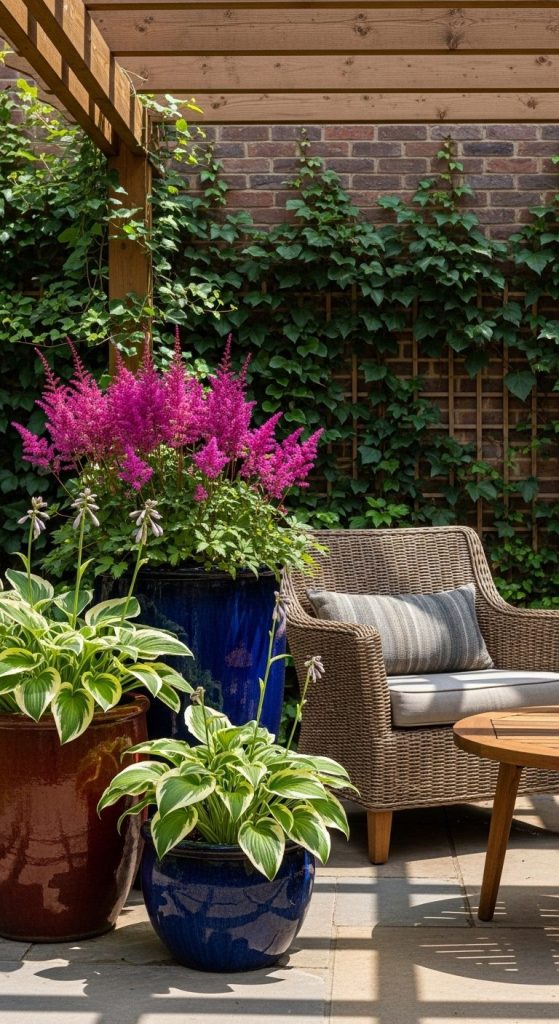
No garden bed? No problem. Astilbes and mini hostas thrive in large containers — perfect for patios, balconies, or shaded porches.
Pros:
- Portable and flexible: move pots for light or design changes.
- Great for renters or small-space gardeners.
- Combine colors and heights creatively in one container.
Cons:
- Containers dry out faster — watering discipline required.
Takeaway: Even in an apartment, you can enjoy the lush textures of shade gardening with the right pot combo.
9. Mixed Texture Layering
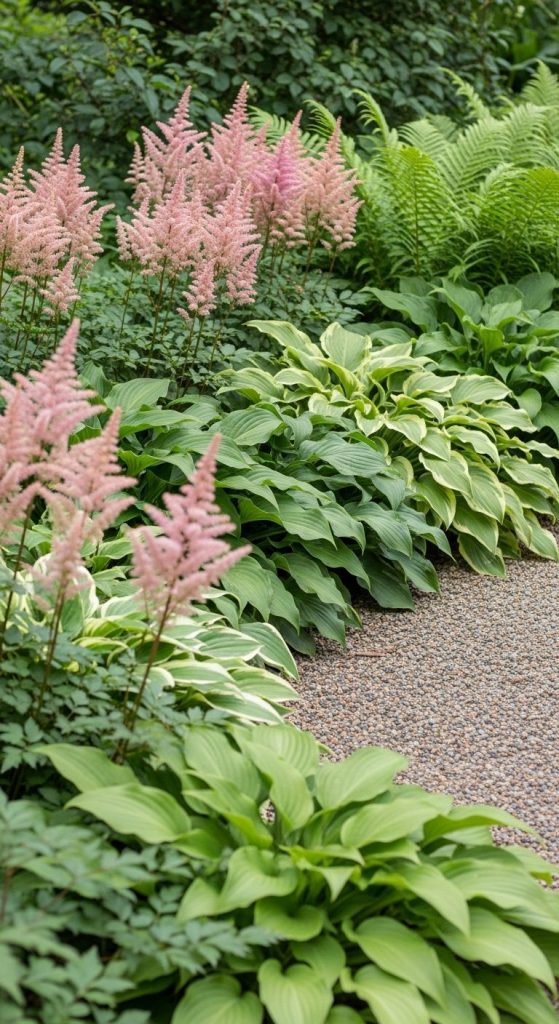
Ever looked at a garden that feels “alive” even without flowers? That’s texture magic. Combine broad hosta leaves with feathery astilbe and add ferns for maximum visual movement.
Pros:
- Texture layering adds dimension and rhythm to shady beds.
- Evergreen groundcovers fill winter gaps.
- Works in both rustic and modern gardens.
Cons:
- Requires balance — too many textures can feel chaotic.
Takeaway: The secret to lasting beauty lies in variety — even subtle contrasts make your shade garden pop.
10. Pink and Chartreuse Color Scheme
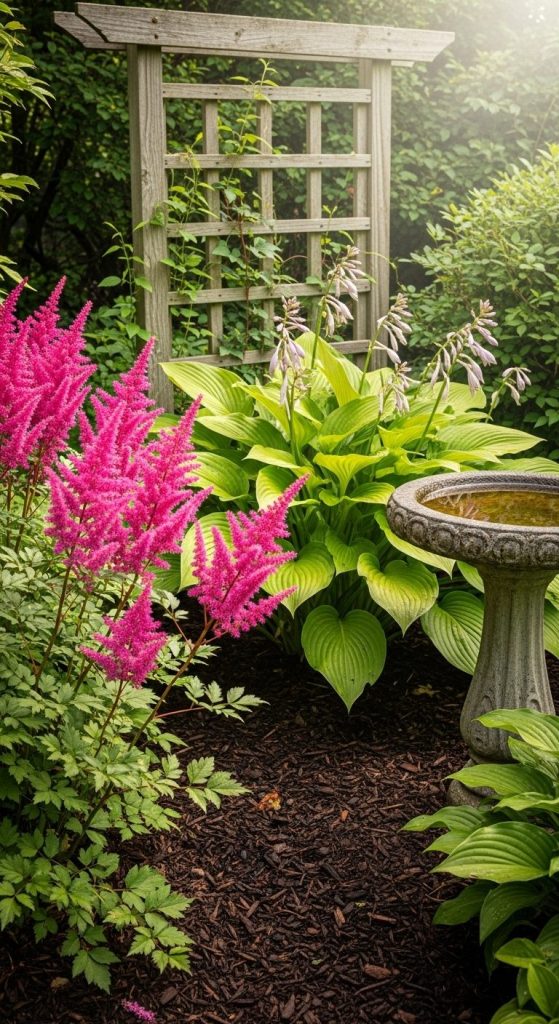
When astilbe’s pink blooms meet lime-green hostas, something special happens. The contrast feels fresh, youthful, and just a bit whimsical — ideal for brightening a dark nook.
Pros:
- High-contrast color makes the space feel lighter and more vibrant.
- Great for garden photography (that pink and green pop is irresistible).
- Encourages bees and butterflies to visit.
Cons:
- May fade in full shade; needs some dappled light for best color.
Takeaway: Pink and chartreuse are the garden’s version of strawberry and cream — classic, irresistible, and uplifting.
11. Woodland Seating Nook
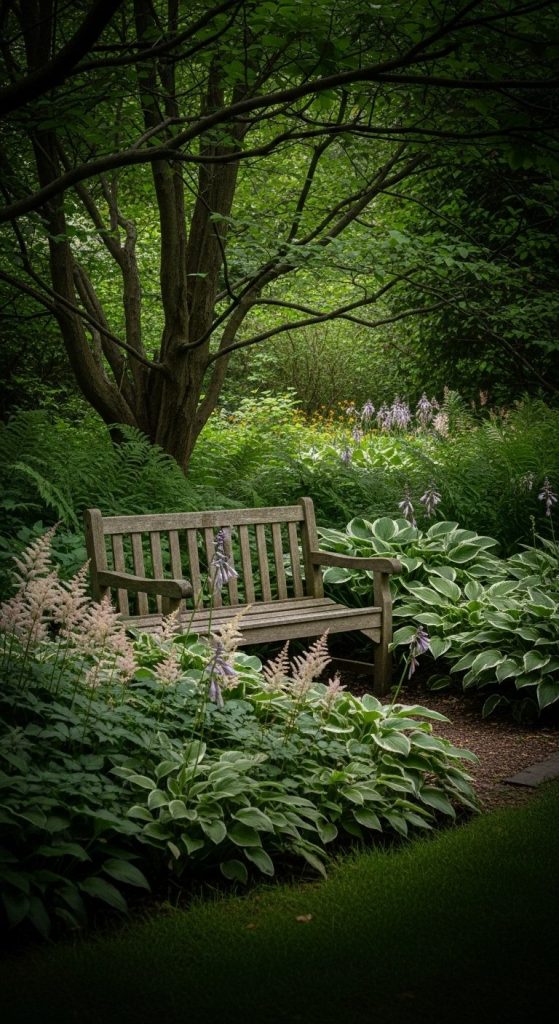
Create a little sitting area surrounded by hostas and astilbes — maybe a bench under a maple tree or a bistro table tucked in shade. It’s your personal retreat.
Pros:
- Offers a cool, peaceful spot on hot afternoons.
- Encourages birds, butterflies, and pollinators.
- Easy to maintain once established.
Cons:
- Fallen leaves can clutter seating areas — regular tidying needed.
Takeaway: Combine function and beauty by turning your garden into a lived-in sanctuary, not just something to look at.
12. Natural Stone Accent Garden

Stone and shade plants are a perfect match. Place astilbes between boulders and hostas along stone steps or retaining walls for a design that feels organic and intentional.
Pros:
- Rocks retain heat and protect plant roots.
- Adds year-round structure and texture.
- Great for sloped or uneven terrain.
Cons:
- Heavy lifting required during setup — worth it though!
Takeaway: Stones give your shade garden bones, and astilbes + hostas bring it to life.
13. White Garden Elegance
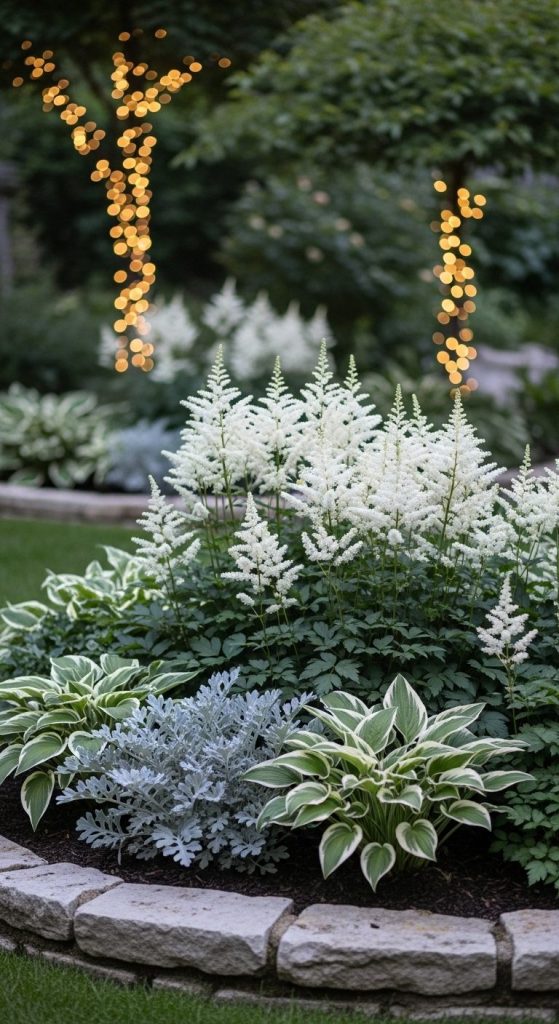
A white-themed garden built around white astilbes and variegated hostas feels crisp and luminous, especially at dusk. It’s the kind of design that glows under moonlight.
Pros:
- Perfect for evening gardens and outdoor dinners.
- White flowers appear larger and cleaner against green backdrops.
- Elegant and timeless aesthetic.
Cons:
- White blooms may brown after heavy rain — deadhead promptly.
Takeaway: A monochrome white garden radiates quiet sophistication — proof that subtle can still stun.
14. Miniature Shade Garden for Small Spaces
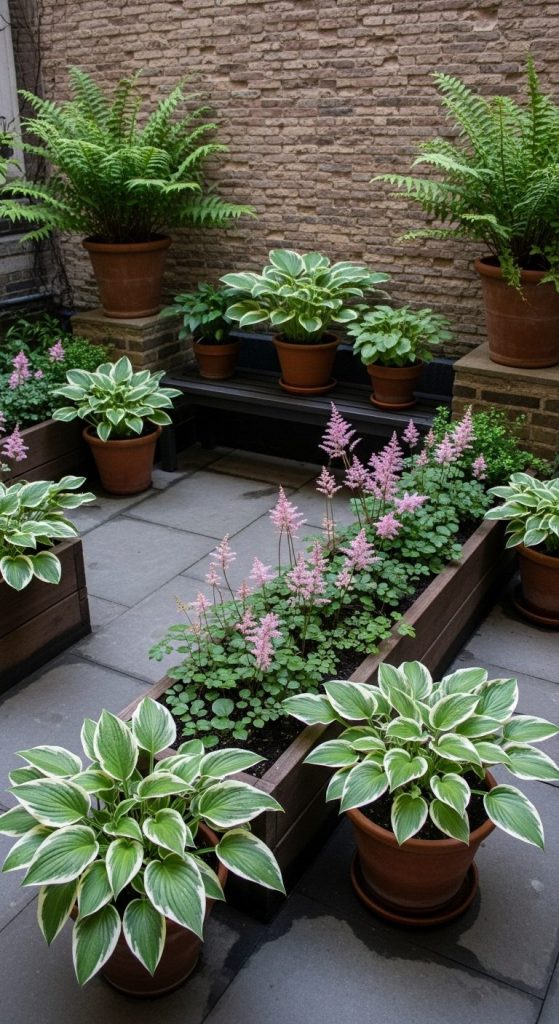
Working with a tiny courtyard or balcony? Choose dwarf hosta varieties and compact astilbes to create a scaled-down version of a woodland garden.
Pros:
- Fits into tight spaces — think city patios or entryways.
- Easy to rearrange or refresh seasonally.
- Great for beginner gardeners.
Cons:
- Small containers dry quickly; watering vigilance is key.
Takeaway: Even a single pot arrangement can deliver the layered beauty of a full garden — just shrink the proportions.
15. Pollinator-Friendly Shade Haven

Astilbes are nectar-rich, and hostas offer late-season blooms bees adore. Combine both to create a pollinator paradise, even in a shady yard.
Pros:
- Supports biodiversity — bees, butterflies, and even hummingbirds.
- Easy to integrate with native plants and woodland perennials.
- Beautiful and eco-friendly.
Cons:
- Avoid pesticides — they can harm your visiting pollinators.
Takeaway: Beauty and purpose meet here. You’re not just gardening — you’re helping the planet in your own small way.
Conclusion: Shade Gardens That Steal the Spotlight
The truth is, not every gardener gets full sun — and that’s okay. Some of the most enchanting spaces I’ve ever seen were built in the cool hush of shade, where leaves whisper instead of shout. Astilbes and hostas thrive where others struggle, painting quiet corners with texture, softness, and soul.
Whether you’re dreaming of a mossy Japanese courtyard, a fairytale woodland path, or a tiny container garden by your door, these plants deliver. They’re adaptable, enduring, and ridiculously photogenic.
So the next time you eye that dim corner of your yard and sigh, remember — that’s not a dead zone. It’s potential waiting for a little astilbe-and-hosta magic. IMO, every garden deserves a spot where lush meets low-maintenance.

William Martin is a passionate bowler who spends most of his weekends playing the sport. With years of intense experience under his belt, William decided to share his knowledge by creating BOWLING OCEAN. Join me on this journey to explore the world of bowling and discover the tips and tricks to becoming a pro.

